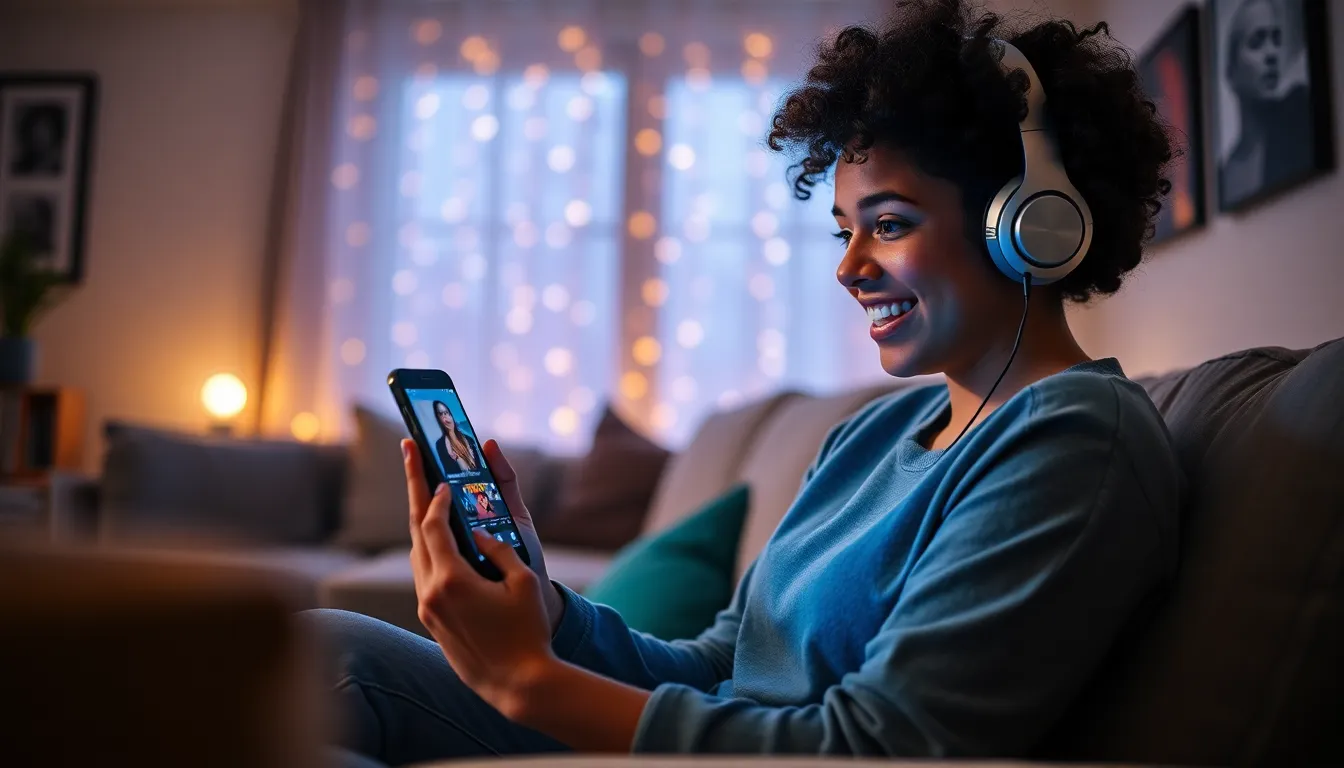Table of Contents
ToggleIn a world where streaming options are as plentiful as cat videos, mood-based streaming has emerged as the hero we didn’t know we needed. Imagine curling up on the couch, feeling a little blue, and instead of scrolling endlessly, you hit play on a curated playlist that lifts your spirits faster than a double shot of espresso. It’s like having a personal DJ for your emotions, ready to drop the perfect track or movie for whatever vibe you’re riding.
What Is Mood-Based Streaming?
Mood-based streaming refers to a digital content delivery approach that aligns media selection with a user’s emotional state. Curated playlists categorized by feelings such as happiness, sadness, relaxation, or excitement offer tailored recommendations. This personalization simplifies the process of discovering new music, movies, and shows.
Users benefit from mood-based playlists, as they enable greater emotional connection to the content. Algorithms analyze user preferences and emotional triggers, ensuring relevancy in chosen media. Platforms integrating mood-based streaming utilize tags or descriptors to group content effectively based on these emotions.
Streaming services like Spotify and Apple Music utilize this concept by creating dynamic playlists. These playlists respond to user feedback, adapting to real-time emotional shifts. Such advancements reflect the increasing demand for personalized user experiences in the digital age.
Emerging technologies also contribute to the evolution of mood-based streaming. Artificial intelligence continually refines algorithms, enhancing accuracy in predicting user preferences. Moreover, these systems learn and adapt over time, ensuring recommendations stay fresh and engaging.
The rise of mood-based streaming addresses the challenges of content saturation faced by users today. By focusing on emotions, users spend less time navigating vast libraries. Enhanced engagement occurs as users discover new content they might have otherwise missed, truly revolutionizing how they experience media.
The Rise of Mood-Based Streaming

Mood-based streaming has gained traction as users seek personalized media experiences that cater to their emotional states. Curated playlists enhance emotional connections and simplify content discovery.
Key Platforms Offering Mood-Based Streaming
Spotify leads the charge with its algorithmic playlists designed for various moods. Apple Music follows closely, offering tailored mixes based on listener behavior. YouTube Music also excels, using user data to recommend songs that align with specific feelings. Deezer provides a feature called “Flow,” allowing users to enjoy personalized music streams that adapt to their current mood. These platforms continuously innovate to enhance user experiences.
Popular Genres in Mood-Based Streaming
Genres like chill-out and lo-fi music feature prominently in relaxation playlists. Upbeat pop and dance tracks dominate mood selections for happiness and energy. For cinematic experiences, soundtracks often resonate with users experiencing nostalgia or reflection. Indie and alternative genres frequently appear in playlists categorized under melancholic moods. With such variety, users easily find content that matches their emotional needs.
The Science Behind Mood-Based Streaming
Understanding the connection between mood and media consumption reveals the impact on user experience. Curated playlists enhance engagement and emotional resonance.
How Music Affects Mood
Music significantly influences mood by activating emotional responses. Upbeat tunes often elevate spirits, while slower melodies can evoke nostalgia or sadness. Research shows music stimulates brain areas linked to pleasure, enhancing emotional states. Playlists tailored to specific moods make it easier for individuals to navigate their feelings through sound. Creating a personal atmosphere using music leads to an improved overall experience. Listeners drawn to particular genres, like lo-fi for relaxation, find instant comfort and connection.
Psychological Benefits of Mood-Based Streaming
Mood-based streaming provides substantial psychological benefits. It simplifies emotional expression, allowing users to connect with their feelings through curated content. This connection fosters a sense of belonging and validation, reducing feelings of isolation. Engaging with music or media reflective of a user’s mood promotes self-regulation, helping to manage stress and anxiety. Additionally, discovering new content that aligns with emotional states can lead to rewarding experiences. This tailored approach to media ultimately strengthens emotional well-being, making mood-based streaming more appealing and beneficial.
Future Trends in Mood-Based Streaming
Emerging trends in mood-based streaming indicate that personalized content delivery will continue to evolve. Enhanced algorithms will analyze user data more effectively, resulting in even more precise recommendations. AI advancements will enable streaming services to detect subtle emotional cues, improving playlist accuracy.
Users will likely experience a shift towards interactive content. This interactivity may involve streaming platforms allowing users to influence playlist direction in real-time, creating a more immersive experience. Social features will become increasingly important, with shared mood playlists enabling friends to connect and curate experiences together.
The rise of voice-assisted technology offers exciting possibilities for mood-based streaming. Smart devices could facilitate seamless content selection based on spoken emotions, transforming how users interact with their favorite media. Additionally, augmented reality (AR) and virtual reality (VR) might provide experimental ways to explore content immersed in specific moods.
Platforms will prioritize diversity in their offerings as trends unfold. Listeners may discover curated selections emphasizing various cultural influences and genres, enriching their emotional listening experiences. Marketing strategies will focus on promoting emotional playlists, highlighting their therapeutic benefits for mental well-being.
Streaming services are set to collaborate with mental health professionals to create carefully designed playlists intended for specific emotional needs. These initiatives may enhance the psychological benefits associated with mood-based streaming, solidifying its position in the mental health arena.
User-generated content will likely gain traction, with individuals sharing their unique playlists based on personal emotional experiences. This trend could foster community engagement and lead to a treasure trove of mood-centered music collections. Flexibility in streaming services will remain essential, as user preferences continue to shift and evolve with emotional landscapes.
Mood-based streaming is transforming how users engage with digital content. By aligning media selection with emotional states, it creates a more personalized and fulfilling experience. The convenience of curated playlists allows individuals to connect with content that resonates with their feelings, enhancing their overall enjoyment.
As technology advances, mood-based streaming is set to become even more intuitive. With AI-driven algorithms and emerging interactive features, users will find it easier to discover new favorites that match their moods. This evolution not only enriches the media experience but also supports emotional well-being, making mood-based streaming a vital aspect of modern entertainment.




